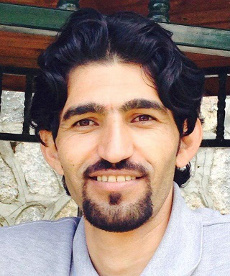Invisible Iranians
Some days I yearn for the time when there was no Internet and information about tragic events was hard to verify and slow to reach us. We were disheartened for sure and truly powerless, but today, being well informed does not necessarily empower us.
In the communication age, news may travel fast, it may even trigger interest in a case of human rights violation when it is not competing with news about the Islamic Republic’s nuclear ambitions or when the victims are well-known or treated with exceptional cruelty ( in the case of stoning for example), but it is much harder to draw media attention to the ordinary people who constitute the pillars of resistance under any oppressive government and whose refusal to submit is most severely punished as they are unknown and thus invisible.
The White House drew valuable and welcome attention to Iran’s decision to execute a Christian pastor for his refusal to convert to Islam. But there are so many more…
Yesterday, I froze in front of my laptop screen, staring at the news of the suicide of a young woman, Nahal Sahabi, in Tehran. Nahal is one of the many young Iranians who find the present unbearable and the future too uncertain to be worth living for. We know of her suicide because she was the girlfriend of the 22-year-old, Behnam Ganji, who committed suicide on Sept. 1, 2011.
Behnam, as I understand from a relative who knew him well, was an optimistic and sensitive young man. He had plans for his future and was enthusiastically cleaning and painting the house that he was going to live in. No one really knows why he decided to end his life. All we know is that his suicide happened three weeks after his release from the infamous Evin Prison in Tehran. Behnam was neither a human rights activist nor a dissident. But these details do not matter in Iran these days. He had the bad luck of being present on July 31, 2011 when plainclothes agents came to arrest his roommate, Kouhyar Goudarzi, a 25-year-old human rights activist. Behnam is one of many ordinary Iranian citizens who become collateral damage every year in the authorities’ persecution of dissidents and remain invisible to the world.
Behanm left behind a video in which he clearly stated that he had lost faith in the worthiness of life, and sent an angry message to the police reminding them that “they are looking for nothing” and they “will find nothing.” So, what could have happened in Evin to have led to Behnam’s suicide and eventually to that of the woman who loved him? Why is it that the third person who was arrested with Kouhyar and Behnam has turned off her cell phone and is not responding to friends since she was released on Aug. 7? Most importantly, why has no one, including Kouhyar’s lawyer, been able to see him or talk to him since his arrest? Why are the authorities unclear about where he is and who is holding him?
Kouhyar’s arrest didn’t come as a surprise. His activism and persistence in calling for the respect of human rights had, since 2006, led to repeated arrests. He spent a year in prison before being released in December 2010 and being expelled from his university. Unlike Kouhyar, Behnam had not been warned about his activities. He was taken along because he was a witness. He was detained and interrogated for more than a week so that he fully understood the danger and would not spread the news. Behnam remained quiet after his release. Kouhyar’s mother was also prevented from talking. She was arrested on Aug. 1 in her home town, Mashad (Khorassan Province). According to the Committee of Human Rights Reporters, Kouhyar’s group, her charge, “disturbing public order” and “acting against national security,” are related to interviews she gave during her son’s previous imprisonment. Her trial has already taken place behind closed doors.
So the news matters and we can play a role by making the information available. But our efforts will not have the necessary impact without international support and visibility in the media. As Iranian activists were discussing ways to draw attention to the fact that no one has heard from Kouhyar in two months or about the suicide of his friends, it became clear that none of the actions they considered: posters on the web, web campaigns, actions in Dupont Circle, a sit-in in front of the Washington Post offices, would guarantee coverage by the mainstream media.
To those of us who are familiar with repressive regimes, the equation is simple. Every time a dissident’s mother or lawyer is arrested, scores of others’ mothers and lawyers are deterred and will remain silent or refuse to follow-up on political cases. We are still getting new names of young people who were killed in 2009, but whose parents had not dared to publicize the news. International support and media interest provide a safe space for people who resist and encourages others to join them. Nothing is as demobilizing for those who fight with tyranny as being invisible or forgotten. What determines political developments in a closed country does not necessarily happen in front of the cameras with tanks rolling over protesters. The most important struggle is a long term fight to be heard and the psychological warfare between the persecuted and the persecutors. The latter’s strength lies in their ability to convince those they persecute that the world doesn’t hear them and that they are irrelevant.
In the summer of 1988, for example, the news of the secret mass killing in Iranian prisons reached us months after several thousand young men and women were secretly hanged and buried. Their main crime was to refuse to submit to the official ideology in spite of years of harsh treatment in Iranian prisons. They were unknown to most of us and to the outside world. They were invisible. Their death was barely noticed and quickly forgotten. In July, 1999, thousands of students came out in the streets to protest a brutal attack on their dormitories. These were for the most part unknown ordinary young Iranians. They were brutally repressed and the world forgot them once they were removed from public view. In their case however, the new means of communication may have had a role in preventing mass executions.
Since 1999, thousands of students have been arrested, tortured, suspended or expelled from their universities for doing what every student does here in the United States. Some died in prison, some were forced into exile, and many more are held hostage with high bail amounts or suspended prison sentences. The pattern was the same, following the well-covered 2009 post-electoral protests. This time however, the prison sentences were much longer and not suspended, and instead of having scores of refugees leave Iran, we are facing a flow of refugees. In each case, many were caught because they were at the wrong place at the wrong time and, like Behnam, they became collateral damage. We can’t draw attention to them because they are not well-known and they are deemed irrelevant.
Understandably, there is much to cover around the world and we cannot expect every human rights violation in Iran to get visibility outside Iran. As activists discussed what the “news hook” would be in the case of Kouhyar’s disappearance and Behnam death, one person suggested the recent suicide of the women who was in love with Behnam. Of course this would be newsworthy if it had happened here in the United States. Those who cover government policies, police brutality, or legal issues in the United States are well aware that the arrest of an ACLU activist for example or the suicide of a person following a week of interrogation may be relevant to their work. However, when it comes to covering other countries, this logic gets lost in a maze of analysis about what is relevant and what is not, in which in spite of years of observation many of us are still lost.
by: Roya Boroumand,

 My Interrogator Said: You Are An Ass, And Asses Do Not Merit Human Rights
My Interrogator Said: You Are An Ass, And Asses Do Not Merit Human Rights